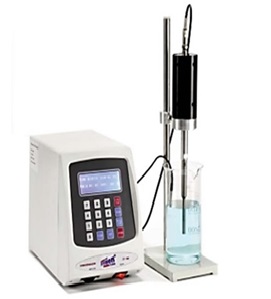Ultrasonic homogenizers disrupt tissues and cells through cavitation and ultrasonic waves. Generally ultrasonic homogenizers consist of three parts:
- A generator which provides and controls the power

- A transducer which contains piezoelectric crystals that convert the electric energy to very high-frequency mechanical motion. The converter also amplifies this signal.
- A titanium probe or “horn” which rapidly vibrates in a longitudinal direction, transmitting the ultrasonic energy to the sample.
Homogenization occurs both directly through the ultrasonic forces as well as through cavitation - the rapid formation and collapse of bubbles. This combination of forces makes ultrasonic homogenizers excellent for cell disruption and particle size reduction.
You may see some examples of where ultrasonic homogenizers are used.
- Breaking up of cells, bacteria, viruses, spores, fungi, or tissues
- Extraction of ingredients
- Homogenization of substances of all kinds
- Dissolution of hard-to-dissolve and extremely hard-to-dissolve substances in fluids
- Production of dispersions and suspensions
- Catalysis and acceleration of chemical reactions.
Ultrasonic homogenizers are also used in many special applications in chemistry, biology, and in various technical fields. For example, ultrasonic homogenizers have found increasing importance in cancer research for the preparation of liposomes in recent years. For medical applications ultrasonic homogenizers are used to isolate viruses and the removal of proteins from specific structures. In order to homogenate waste water ultrasonic homogenizers can be used. For technical purposes it can be said that for determination of grain size in the analysis of minerals ultrasonic homogenizers are used. In chemistry, for example, the reactivity of metals such as lithium, magnesium, zinc, or aluminum can be increased by removing the oxidized layer from their surfaces by ultrasonic exposure. Ultrasonic homogenizers also have a catalytic effect in reactions of powders. The catalytic particles are made finer through cavitation, producing a larger reaction surface. By obtaining fine particle catalysts, the catalytic effects of the metal can be increased more than 100.000 times. Homogenizers can also be used in forming organometallic complexes, for the destruction of large molecular chains (depolymerization), and for the liquefaction of metal particles in fluids. When you used ultrasonic homogenizers you can see that the "cracking" from alkanes into desired smaller fragments, which usually occurs at temperatures more than 500 °C, will occur even at room temperature.
In the laboratory of the German Red Cross in Berlin, a discovery was made which saves a large amount of time and work in paternity tests by using ultrasonic homogenizers to prepare for the extensive analyses. In this way, a stroma-free hemolysate, a blood solution in which the basic cellular tissue is removed, is produced. Ordinarily the solution must be acted upon by toluol at 4 °C for at least half an hour and the tissue be shaken out manually in toluol. Using an ultrasonic homogenizer, however, the blood solution is simply exposed to ultrasonics a few seconds and the cell structure is mechanically destroyed. Storage and haking out are eliminated, reducing the preparation time from more than 30 minutes to about 5 seconds. This detailed example indicates some essential aspects of the practical use of ultrasonic homogenizers.
You may order of ultrasonic homogenizers from the link given below:
Comments
Post a Comment